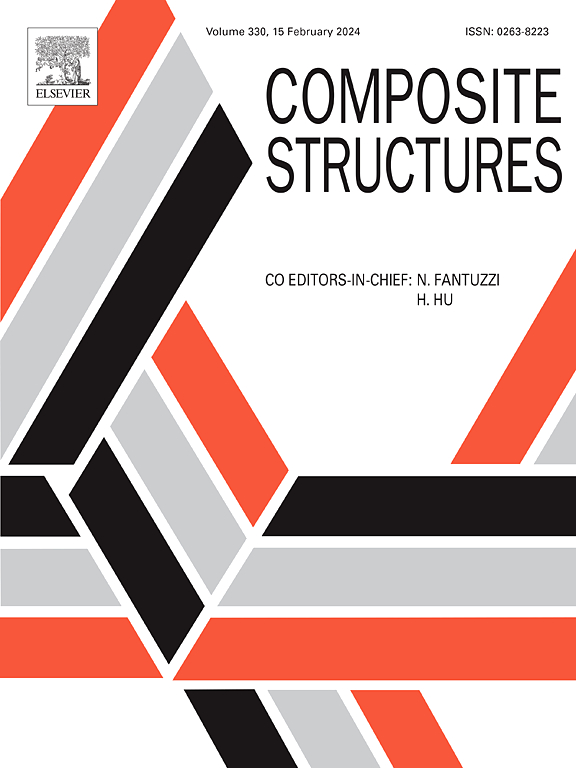薄壁变角束丝缠绕复合圆柱体的径向压缩,第1部分:在线弹性状态下的制造、实验和计算分析
IF 6.3
2区 材料科学
Q1 MATERIALS SCIENCE, COMPOSITES
引用次数: 0
摘要
本文对薄壁变角束丝缠绕复合材料圆柱体在线弹性状态下的径向压缩行为进行了计算-实验研究。通过将圆柱体细分为几个环形区域,每个区域具有恒定的纤维角度,可实现可变角度配置,从而概述了制造细节。实验旨在描述这些结构在刚度方面的力学行为,并利用数字图像相关获得应变场。研究了两种相同直径的样品类型:长度为150mm和200mm的圆柱体。对于150毫米的圆柱体,沿着整个长度捕获应变场,而对于200毫米的圆柱体,感兴趣的区域被简化为马赛克图案的单个三角形亚单元。这种方法允许观察全局和局部应变场趋势,并将有限元模型结果与实验数据进行比较。计算模型验证了良好的结果,然后将其用于模拟第二部分中研究的带有应力集中器的圆柱体的情况,使用Hashin失效准则预测失效的开始。本文章由计算机程序翻译,如有差异,请以英文原文为准。

Radial compression of thin-walled variable-angle tow filament-wound composite cylinders, Part I: Manufacture, experimental, and computational analyses in the linear-elastic regime
This work presents a computational-experimental investigation into the radial compression behavior of thin-walled variable-angle tow filament-wound composite cylinders in the linear-elastic regime. The manufacturing details are outlined with the variable-angle configuration achieved by subdividing the cylinder into several annular regions, each with a constant fiber angle. The experiments aim to describe the mechanical behavior of these structures in terms of stiffness and to obtain strain fields using digital image correlation. Two sample types with the same diameter are studied: cylinders with lengths of 150 mm and 200 mm. For the 150 mm cylinders, strain fields are captured along the entire length, whereas, for the 200 mm cylinders, the region of interest is reduced to a single triangular subunit of the mosaic pattern. This approach allowed for the observation of both global and local strain field trends, with finite element model results compared to experimental data. The computational model was validated with good results, which were then used to simulate cases of cylinders with stress concentrators, which are investigated in Part II, predicting the onset of failure using Hashin’s failure criteria.
求助全文
通过发布文献求助,成功后即可免费获取论文全文。
去求助
来源期刊

Composite Structures
工程技术-材料科学:复合
CiteScore
12.00
自引率
12.70%
发文量
1246
审稿时长
78 days
期刊介绍:
The past few decades have seen outstanding advances in the use of composite materials in structural applications. There can be little doubt that, within engineering circles, composites have revolutionised traditional design concepts and made possible an unparalleled range of new and exciting possibilities as viable materials for construction. Composite Structures, an International Journal, disseminates knowledge between users, manufacturers, designers and researchers involved in structures or structural components manufactured using composite materials.
The journal publishes papers which contribute to knowledge in the use of composite materials in engineering structures. Papers deal with design, research and development studies, experimental investigations, theoretical analysis and fabrication techniques relevant to the application of composites in load-bearing components for assemblies, ranging from individual components such as plates and shells to complete composite structures.
 求助内容:
求助内容: 应助结果提醒方式:
应助结果提醒方式:


